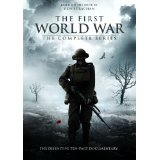“The First World War shaped the 20th century. It sparked the Russian Revolution, and it launched America as a world power. The fault lines from its failed peace settlement led to a second terrible world war barely 20 years later. We all live with its unresolved consequences…”
The First World War long existed in the shadow of the second. When it was fought, the term World War was not yet in existence. Until after the Second World War, it was referred to mostly as The Great War. The footage from this war is far more rare. Most of us have seen little of it. Clips from the Second World War have been used over and over for countless documentaries. There are no longer any survivors left alive from that Great War. You won’t find them interviewed on television, and you won’t hear their stories told to the extent you’ve heard accounts of other conflicts. The results of that war do still live with us today, but how many of us truly understand any of it? The First World War: The Complete Series changes all of that. It’s appropriate as we honor our brave soldiers on Memorial Day and as we begin to live through the 100 year anniversaries of that war to look back… and remember.
The start of the war is more complicated than just the assassination of an Archduke. Unprecedented feelings of nationalism, an intricate web of alliances, and an arms race fed by new technologies in weapon technologies: all of this created a powder keg that was merely ignited by that fateful assassination. It’s a story worth hearing in the detail provided here.
Narrator Jonathan Lewis takes us on a 10-hour journey through the complicated details of this war. He examines not only the events but the consequences of those events. What we get is a comprehensive look at the intricacies of World War I. There is a ton of vintage footage here, more than I thought existed. Of course, much of it is rough and scratchy. A surprising amount of the footage is in fairly good shape with detail that is quite shocking. Many of these images are brutal and not for the fainthearted. Footage and photographs provide uncomfortable, yet compelling images of bodies in various stages of mutilation and decay. As you watch, try to remember that each was a person with all of the emotions, ambitions and day-to-day trappings of our own lives. There is rare color footage here that displays some of the pageantry and pomp of war. Some of the footage comes from feature film productions shortly after the real events.
Because it was so long ago, there are no interviews with participants or witnesses here. The interviews are from historians. There is actually even very little of that. Much of the story comes from the very words of participants, but in actors’ voices reading from letters, journal entries and official records. The cameras visit many of the locations as they exist today, offering a stark contrast to the war era itself.
Based on the book by Hew Strachan, the episodes are presented in a logical and easy-to-follow manner. You get 10 episodes on three discs. It was released on Channel 4 in England in 2003. Now it makes its way to your television.
We call the World War II fighters The Greatest Generation. Without taking anything away from those brave men and women, it’s time that the soldiers of The First World War were given their due. Over 30 million were killed over four years. A year later Europe would lose another 20 million to the flu epidemic. Another 30 million would leave for America in those same years. Imagine a population that loses 80 million people in half a decade? It’s almost unimaginable there was a fighting force to be had to do it all over again 20 years later. World War I and II is a perfect example of history repeating itself. Maybe it’s time to learn the lessons here and now. This collection isn’t a bad way to start. “At the time it was seen in positive terms, for defense against aggression. For glory. But it was not the war to end all wars. Its terrible message to the century was that war can fulfill ambition. That war can work.”



